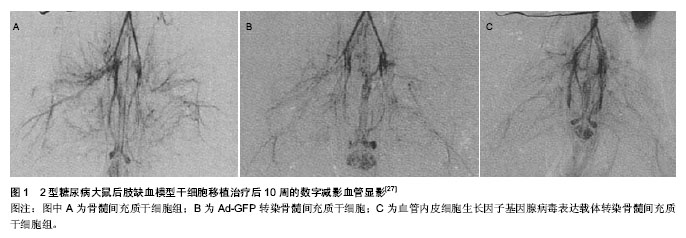| [1] 焦雪琴,申雅君,姚建宇,等.2型糖尿病下肢血管病变的危险因素分析[J].现代生物医学进展,2013,13(19):3714-3717.
[2] Williams LH, Miller DR, Fincke G, et al. Depression and incident lower limb amputations in veterans with diabetes. J Diabetes Complications. 2011;25(3):175-182.
[3] 许金秀,耿风芹,王光亚,等.抑郁症与2型糖尿病患者下肢血管病变关系的探讨[J].中国医药导刊,2014,15(3):387-388.
[4] Makine C, Kar?ida? C, Kadio?lu P, et al. Symptoms of depression and diabetes-specific emotional distress are associated with a negative appraisal of insulin therapy in insulin-naïve patients with Type 2 diabetes mellitus. A study from the European Depression in Diabetes [EDID] Research Consortium. Diabet Med. 2009;26(1):28-33.
[5] Zebrack JS, Anderson JL. Role of inflammation in cardiovascular disease: how to use C-reactive protein in clinical practice. Prog Cardiovasc Nurs. 2002;17(4):174-185.
[6] 邱明才,春梅.糖尿病并发症发病过程中的补体活化作用[J].中华内分泌代谢杂志,2006,22(3):303-305.
[7] 李芳平,宁艳辉.2型糖尿病下肢血管病变炎症因子及丹参的干预作用[J].中西医结合心脑血管病杂志,2007,5(12):1177-1178.
[8] 南登崐.康复医学[M].北京:人民卫生出版社,1994.
[9] Sosnowski C, Pasierski T, Janeczko-Sosnowska E, et al. Femoral rather than carotid artery ultrasound imaging predicts extent and severity of coronary artery disease. Kardiol Pol. 2007;65(7):760-768.
[10] 贾安奎,刘彦轩,仲华,等. 2型糖尿病患者血小板-白细胞聚集体与微血管病变部位及区域数量的关系[J].中国糖尿病杂志,2014, 22(4):347-349.
[11] 胡春秀,李力.基因印迹与胚胎生长发育[J].第三军医大学学报, 2000,22(8):810-812.
[12] 马绍杰,王颖,金秀平,等.血清瘦素与2型糖尿病下肢大血管病变的关系探讨[J].中国心血管研究杂志,2004,2(8):613-614.
[13] 谢晓敏,刘惠莉,于丽萍,等.2型糖尿病下肢血管病变患者中瘦素、白介素-6,C反应蛋白的改变[J].第四军医大学学报,2007, 28(4): 338-341.
[14] Bordier L, Le Berre JP, Garcia C, et al. Influence of blood pressure level on urinary albumin excretion rate and erythropoietin production in diabetic patients. Arch Mal Coeur Vaiss. 2006;99(7-8):701-704.
[15] 侯莉.2型糖尿病患者血清PECAM-1和MIF水平变化相关机制及作用[J].镇江:江苏大学,2013.
[16] Tepper OM, Galiano RD, Kalka C, et al. Endothelial progenitor cells: the promise of vascular stem cells for plastic surgery. Plast Reconstr Surg. 2003;111(2):846-854.
[17] 邢帅,陈剑秋.干细胞移植治疗糖尿病下肢缺血性疾病的研究进展[J].国际检验医学杂志,2012,33(1):56-58.
[18] 周晨光,宫经新,马跃,等.糖尿病对内皮祖细胞移植促血管新生作用的影响[J].中国组织工程研究,2013,17(6):1044-1048.
[19] 高登鹏.不同糖环境对FGL2基因沉默后的大鼠心肌微血管内皮细胞全基因表达谱的影响[D].南昌:南昌大学,2013.
[20] 樊明世,杨晓凤,吴雁翔,等.人脐带间充质干细胞移植改善糖尿病兔下肢缺血[J].中国组织工程研究与临床康复,2011,15(1): 33-36.
[21] 刘艳枚.人VEGF基因修饰大鼠骨髓间充质干细胞移植治疗糖尿病后肢缺血研究[D].遵义:遵义医学院,2012.
[22] 毛红,赵湜,王红祥,等.自体外周血干细胞移植治疗糖尿病下肢血管病变与糖尿病足效果:89例自身对照观察[J].中国组织工程研究与临床康复,2008,12(21):4197-4200.
[23] 陈明卫,李燕萍,唐益忠,等.不同来源和移植途径的自体干细胞治疗糖尿病缺血性下肢血管病变的随机对照研究[J].中华临床医师杂志:电子版,2013(14):6418-6423.
[24] 高雪,叶吉云,曾希云,等.干细胞重建糖尿病足缺血态组织血流[J].昆明医科大学学报,2012,33(10):57-60.
[25] 李华,陈旭艳,冯亮华,等.自体外周血干细胞移植治疗糖尿病下肢缺血效果观察[J].中国综合临床,2011,27(9):958-961.
[26] 阚艳敏,马琳,李静,等.糖尿病肾病患者外周大动脉的弹性变化[J].浙江临床医学,2014,16(4):638-639.
[27] 周飞,张小芬.脐血干细胞移植的研究及临床应用[J].医学综述, 2006,12(19):1183-1185.
[28] 于凤泉,李群,李富元,等.血管重建治疗糖尿病缺血性血管病变对血管内皮生长因子及内皮素的影响[J].中国现代医药杂志,2014, 16(1):48-50.
[29] 杨耀国.人脐带血干细胞移植治疗糖尿病鼠下肢缺血的研究[D].北京:北京协和医学院,中国医学科学院,2009.
[30] Tateno K, Minamino T, Toko H, et al. Critical roles of muscle-secreted angiogenic factors in therapeutic neovascularization. Circ Res. 2006;98(9):1194-1202.
[31] 章涛,刘艳枚,张潜,等.血管内皮生长因子基因修饰骨髓间充质干细胞移植治疗大鼠糖尿病后肢缺血[J].解剖学杂志,2013,36(5): 901-905.
[32] 王伏生,梁宏莉,姜鸿南,等.血管生长因子基因裸质粒DNA转染自体外周血干细胞联合移植治疗下肢缺血性疾病[J].临床医药实践, 2011,20(1):8-11. |
